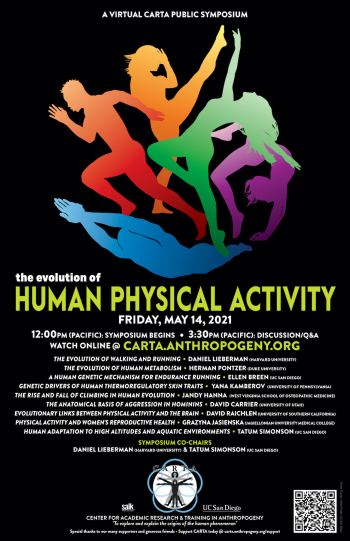The Evolution of Human Physical Activity
Tatum Simonson, UC San Diego School of Medicine
Daniel Lieberman, Harvard University
Summary:
Exercise is well known to provide many health benefits, and human physical activities differ significantly from other species. Although hunter-gatherers sometimes climb and fight, they also walk long distances bipedally (the topic of a previous CARTA symposium) as well as run, dig, throw, carry and more. How, when and why did these capabilities evolve? What genetic, physiological and anatomical adaptations underlie them? And how did the evolution of human physical activity affect other key human characteristics such as enlarged brains, high-quality diets, extended life-history strategies, gene-culture co-evolution and high levels of cooperation? To address these and other related questions, this symposium will integrate research on genetics, biomechanics, physiology, neurobiology and behavior. Because more and more humans today are primarily sedentary, we will also explore implications of the evolution of human physical activity for contemporary health and disease.
Media for each talk can be played by clicking on icons in the table below, or by clicking on the individual talk titles below and then the attachment file at the bottom of the page.
| Speakers | Media | Session |
|---|---|---|
 Margaret Schoeninger  Daniel Lieberman |
|
Welcome & Opening Remarks |
 Daniel Lieberman |
|
The Evolution of Walking and Running All animals need to be physically active, but the human lineage clearly underwent selection to be considerably more physically active than our relatively inactive ape ancestors and cousins including chimpanzees and gorillas. This selection likely occurred in at least two stages, first involving the most fundamental type of moderate physical activity, walking, and then the most fundamental type of vigorous physical activity, running. In terms of walking, the earliest hominins were likely... read more |
 Herman Pontzer |
|
The Evolution of Human Metabolism From an evolutionary perspective, life is a game of turning energy into offspring. The strategies that species use to acquire energy, in the form of food, and allocate energy to the essential tasks of growth, maintenance, movement, and reproduction, are incredibly diverse and reflect the ecological pressures and opportunities encountered. In this talk, I discuss the deep evolutionary history of the human metabolic strategy and our divergence from other apes, focusing on metabolic changes over... read more |
 Ellen Breen |
|
A Human Genetic Mechanism for Endurance Running Humans are unusual among primates in being capable of sustained long-distance running, a key phenotype that emerged in genus Homo about 2 million years ago (Mya). The underlying genetic changes that defined this exercise phenotype are not well understood. About 2-3 mya, an exon deletion in the CMP-Neu5Ac hydroxylase (CMAH) gene became fixed in our ancestral lineage, completely eliminating the hydroxylase activity required to add an oxygen atom to the sialic acid Neu5Ac to form Neu5Gc. Thus... read more |
 Yana Kamberov |
|
Genetic Drivers of Human Thermoregulatory Skin Traits Humans use sweating as the primary mechanism to dump body heat. Humans’ ability to effectively harness sweating as a thermoregulatory mechanism is a product of the evolution of a massively increased sweat gland density and a drastic reduction in the size of body hair. Accordingly, humans have the distinction of being the “the naked sweaty ape”. I will present the advances our lab has made in identifying the genetic basis for how these unique and essential adaptations of human physiology evolved... read more |
 Jandy Hanna |
|
The Rise and Fall of Climbing in Human Evolution Most primates live and move in the trees, but humans have evolved to move bipedally on the ground. Primates’ arboreal life-style has long been thought to have allowed the evolution of human beings’ unusual form of movement. We know much about how horizontal movement on branches (or simulated branches) differs in primates relative to most other mammals. But only recently have we begun to learn about how vertical movement (i.e. climbing) is accomplished by non-human primates, and how such... read more |
 Pascal Gagneux |
|
Anthropocise: Anthropogeny Exercises Dr. Pascal Gagneux, CARTA's Associate Director, leads an "Anthropocise" break in "The Evolution of Human Physical Activity" symposium |
 David Carrier |
|
The Anatomical Basis of Aggression in Hominins Our thesis, that humans are at some level anatomically specialized for physical aggression, is based on two premises. First, although humans are arguably the most empathic and cooperative species on the planet, we also have a real problem with violence. Second, to the extent we can find ways to reduce aggression, intolerance, and violence in the future we should do so. As scientists, we know that the best solutions to our most important problems stem from understanding. Evidence that human... read more |
 David Raichlen |
|
Evolutionary Links Between Physical Activity and the Brain Recent work suggests exercise can have important beneficial effects on the aging brain, however the underlying mechanisms remain poorly understood. An evolutionary-neuroscience approach may help us better understand these mechanisms and can provide a foundation for developing novel interventions to improve brain aging. Here, we suggest that, from an evolutionary perspective, physical activity mainly occurred during foraging, which combines aerobic activity with cognitively demanding tasks (e.g... read more |
 Grazyna Jasienska |
|
Physical Activity and Women's Reproductive Health It is generally assumed that humans need physical activity to stay healthy, but health recommendations are rarely different for women and men. However, the effects of physical activity on female physiology and health are much more complex. Just like in men, activity is beneficial for many aspects of health, but physically active women also face important physiological trade-offs, or, in other words, quid pro quos. In this talk, I will discuss beneficial aspects of exercise for women,... read more |
 Tatum Simonson |
|
Human Adaptation to High Altitudes and Aquatic Environments Humans have persisted for hundreds of generations under challenging environmental extremes. Adaptations to such environments have been essential for survival, enabling populations to trek successfully among high mountain tops or to dive deeply into vast seas. Unique genetic signatures, resulting from thousands of years of strong selective pressures in these environments, have been discovered within the DNA of present-day populations. These findings provide important clues into evolutionary... read more |
 All Speakers  Ajit Varki |
|
Question & Answer Session and Closing Remarks |
| Attachment | Size |
|---|---|
| 510.9 KB | |
| 1.74 MB | |
| 197.7 KB |
If you enjoy this event, please consider supporting CARTA's quest to explore and explain the human phenomenon.


